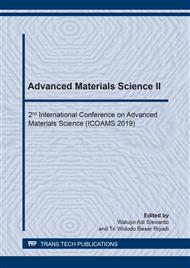[1]
K. Verma and H. Garg, Underwater Welding-Recent Trends and Future Scope,, Int. J. Emerg. Technol., vol. 3, no. 2, p.115–120, (2012).
Google Scholar
[2]
E. F. Alajmi and A. A. Alqenaei, Underwater Welding Techniques,, Int. J. Eng. Res. Appl., vol. 7, no. 2, p.14–17, (2017).
Google Scholar
[3]
D. Fydrych, G. Rogalski, and J. Łabanowski, Problems of Underwater Welding of Higher-Strength Low Alloy Steels,, no. 5, p.187–195, (2014).
Google Scholar
[4]
M. Chandra Joshi, D. S. Rautela, R. Chauhan, and S. Suyal, Scrutinize Research on Underwater Welding Process: A Review,, IOSR J. Mech. Civ. Eng., vol. 13, no. 05, p.74–78, (2016).
DOI: 10.9790/1684-1305067478
Google Scholar
[5]
V. Shivakumara, Babu, Kumar, Optimization of Shielded Metal Arc Welding Parameters for Welding of Pipes by using Taguchi Approach,, Int. J. Eng. Sci. Technol., vol. 4, no. 5, p.2083–2088, (2012).
Google Scholar
[6]
A. Singh and N. K. Grover, Weld Properties of Low Carbon Steel Using Shielded Metal Arc Welding,, Appl. Mech. Mater., vol. 813–814, p.486–490, (2015).
DOI: 10.4028/www.scientific.net/amm.813-814.486
Google Scholar
[7]
M. A. Shomad and M. Shahar Mushfi, Analisis pengaruh variasi elektroda las e6013 dan e7018 terhadap kekuatan tarik dan kekerasan pada bahan baja ss 400,, Din. Tek. Mesin, vol. 7, no. 2, p.73–79, (2017).
DOI: 10.29303/d.v7i2.156
Google Scholar
[8]
J. Arifin, Baja adalah logam paduan dengan besi sebagai unsur dasar dan karbon sebagai unsur paduan utamanya . Kandungan karbon dalam baja berkisar antara 0 , 2 % hingga karbon dalam baja adalah sebagai unsur pengeras dengan mencegah dislokasi,, Momentum, vol. 13, no. 1, p.27–31, (2017).
DOI: 10.53675/jgm.v1i1.55
Google Scholar
[9]
C. Sharma, A. Sharma, and P. Sharma, Investigation of SMAW Joints By Varying Concentration of Rutile ( TiO 2 ) in Electrode Flux,, Int. J. Eng. Res. Gen. Sci., vol. 2, no. 5, p.281–288, (2014).
Google Scholar
[10]
J. Łabanowski, Development of under-water welding techniques,, Weld. Int., vol. 25, no. 12, p.933–937, (2011).
DOI: 10.1080/09507116.2010.540847
Google Scholar
[11]
W. D. Callister and J. Wiley, Materials Science, 2007th ed.
Google Scholar
[12]
P. Tegehall and D. Ph, Review of the Impact of Intermetallic Layers on the Brittleness of Tin-Lead and Lead-Free Solder Joints.,.
Google Scholar
[13]
S. Kobayashi and T. Yakou, Control of intermetallic compound layers at interface between steel and aluminum by diffusion-treatment,, Mater. Sci. Eng. A, vol. 338, no. 1–2, p.44–53, (2002).
DOI: 10.1016/s0921-5093(02)00053-9
Google Scholar
[14]
H. Ma, R. Qiu, J. Liu, and Y. Zhao, Study on the Growth Mechanism of Intermetallic Compounds in Solid Interface of Aluminum / Steel,, vol. 120, no. Ifeesm 2017, p.855–858, (2018).
DOI: 10.2991/ifeesm-17.2018.160
Google Scholar
[15]
ASTM E80, Metode Uji Standar untuk,, vol. 1687, no. C, p.1–27, (2010).
Google Scholar
[16]
C. K. Ogbunnaoffor and J. U. Odo, The Effect of Welding Current and Electrode Types on Tensile Properties of Mild Steel,, vol. 7, no. 5, p.1120–1123, (2016).
Google Scholar
[17]
A. K. Pandey, M. I. Khan, and K. M. Moeed, Investigation of the Effect of Current on Tensile Strength and Nugget Diameter of Spot Welds Made on Aisi-1008 Steel Sheets,, Int. J. Tech. Res. Appl., vol. 1, no. 1, p.1–8, (2013).
Google Scholar
[18]
G. H. S. F. L. Carvalho, I. Galvão, R. Mendes, R. M. Leal, and A. Loureiro, Formation of intermetallic structures at the interface of steel-to-aluminium explosive welds,, Mater. Charact., (2018).
DOI: 10.1016/j.matchar.2018.06.005
Google Scholar
[19]
W. Zhang, D. Sun, L. Han, W. Gao, and X. Qiu, Characterization of intermetallic compounds in dissimilar material resistance spot welded joint of high strength steel and aluminum alloy,, ISIJ Int., vol. 51, no. 11, p.1870–1877, (2011).
DOI: 10.2355/isijinternational.51.1870
Google Scholar
[20]
T. An and F. Qin, Microelectronics Reliability Effects of the intermetallic compound microstructure on the tensile behavior of Sn3 . 0Ag0 . 5Cu / Cu solder joint under various strain rates,, Microelectron. Reliab., vol. 54, no. 5, p.932–938, (2014).
DOI: 10.1016/j.microrel.2014.01.008
Google Scholar
[21]
Talabi, O. B, and J. A, Effect of welding variables on mechanical properties of low carbon steel welded joint,, p.181–187, (2014).
Google Scholar
[22]
W. Geng, D. Wu, D. Sun, H. Li, and Y. Che, Microstructures and Mechanical Properties of Plasma Arc Welded Joints of Ultra-high Strength Steel and Aluminum Alloy Using Al – Si and Al – Cu Fillers,, vol. 58, no. 6, p.1108–1116, (2018).
DOI: 10.2355/isijinternational.isijint-2017-699
Google Scholar
[23]
T. Wang, H. Sidhar, R. S. Mishra, Y. Hovanski, P. Upadhyay, and B. Carlson, Evaluation of intermetallic compound layer at aluminum / steel interface joined by friction stir scribe technology,, Mater. Des., vol. 174, p.107795, (2019).
DOI: 10.1016/j.matdes.2019.107795
Google Scholar


